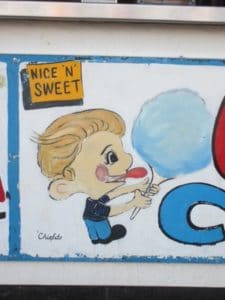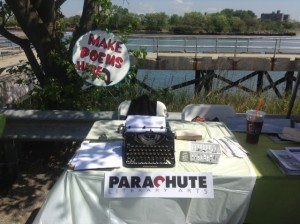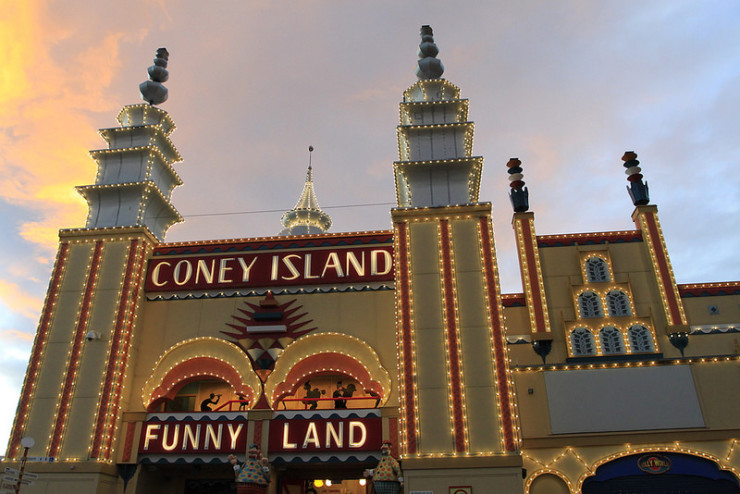Before there was Disneyland and Six Flags, there was Coney Island. Located on the southern end of the Borough of Brooklyn in New York City, Coney Island was the largest amusement park in the United States between 1880 and World War II. Today, the iconic park has two amusement complexes—Luna Park and Deno’s Wonder Wheel Amusement Park—and numerous entertainment sites not included in the two parks.
Its impact on American popular culture has been large. Consider root beer and the Coney Island hot dog. The roller coaster. The carousel. The area was one of the first to use new technologies like electric light. And the first baby incubator debuted there.

Photo by Parachute Literary Arts
Coney Island is still a popular destination for New Yorkers and visitors, but it has changed considerably over the decades. It is also gaining a reputation for poetry.
Poetry?
In 2009, native New Yorker and poet Amanda Deutch organized a poetry festival for Coney Island. Seven years later, Deutch heads Parachute Literary Arts, a community arts organization that “celebrates poetry in Coney Island and makes poetry available to those who live and work in the Coney Island neighborhood.”
Parachute focuses on three kinds of activities: the festivals, held periodically (2009, 2012, and one scheduled for 2017); poetry workshops for students and adults outside the regular classroom; and poetry “events, ” like creating poetry libraries for organizations and a “Poem-a-Rama” in 2015.
All of this happens within the context of place—and the place is Coney Island. Even the organization’s name comes from one of the local iconic landmarks. The Parachute Jump was a ride at the 1939 New York’s World Fair, and when the fair ended was moved to Steeplechase Park, one of the area’s amusement parks. Steeplechase Park is long gone, but the Parachute Jump tower still stands as a Coney Island landmark (it no longer operates as a ride).
Last year’s “Poem-a-Rama” centered on Coney Island’s big Ferris wheel, known as the Wonder Wheel. Students from Parachute’s workshops joined with established poets at the landmark attraction to read and discuss poetry, both on the ground and on the Wonder Wheel itself. The cars were temporarily transformed into small-group “salons” to read and discuss poetry. The event experienced some unexpected “atmosphere” when fog rolled in.
The workshops have been organized with two local organizations—the Rachel Carson High School for Coastal Studies and the New York City Housing Authority (NYCHA). Different area poets lead the workshops. And the high school and the NYCHA’s Surfside Gardens housing complex have two of the poetry libraries. Using social media, Parachute has solicited newly published poetry books from poets and publishers to stock the libraries.

Photo by Parachute Literary Arts
Deutch, a native of New York City and the author of four poetry chapbooks, knows her Coney Island. Her mother, uncle, and grandmother all lived in Coney Island. She’s known the area as a child and as an adult. She currently lives “by the water” in Brooklyn, and described how she came to create Parachute in an article for Poets & Writers Magazine. Its original purpose was to host the 2009 poetry festival, and it grew from there. She’s also involved with a project called Coney Island History, and has done several interviews for it.
Parachute has one additional staff member, Susan Brennan, who serves as Festival Associate. She is a screenwriter and poet, and the author of a chapbook entitled numinous and a full-length collection entitled Drunken Oasis.
Parachute Literary Arts is about poetry and place, and how a community can become connected through poetry. This place just happens to be the nation’s oldest amusement park. One can almost smell the poetry in the cotton candy, the hot dogs, the sand and salt air, the suntan lotion, the screams from the amusement park rides, the music blaring over loudspeakers, and the warmth of the nights.
Photo by Jeffrey Wong, Creative Commons, via Flickr. Post by Glynn Young, author of the novels Dancing Priest and A Light Shining, and Poetry at Work.
__________________________

“I require all our incoming poetry students—in the MFA I direct—to buy and read this book.”
—Jeanetta Calhoun Mish
- Poets and Fables: Steven Flint and “The Sun and the Boy” - July 3, 2025
- Poets and Poems: Alison Blevins and “Where Will We Live if the House Burns Down?” - July 1, 2025
- Poets and Poems: Paul Pastor and “The Locust Years” - June 26, 2025

L.L. Barkat says
So fun to read about the history of Coney Island. And I loved learning more about Parachute. Such interesting things going on in unexpected places throughout the Country! 🙂
Glynn says
I’m trying to imagine reciting Keats while on a roller coaster.
Bethany says
At first, I didn’t see how Coney Island and poetry would naturally find each other. But then again, “the area was one of the first to use new technologies like electric light. And the first baby incubator debuted there.” Ah! It makes sense that an area known for giving space first to fun, and then to fascinating innovations, would end up hosting this creative gathering for poets. I enjoyed listening to a few of the poets in the video.
Thanks for the interesting post.
Glynn says
Poetry reflects the lives and experiences of people – and an amusement park certainly makes an interesting backdrop!
Sandra Heska King says
This was way fun. I loved the video and especially loved the last paragraph. I smell poetry…
Glynn says
Yep, that was the point, I think! Thanks, Sandra!
Larry Bole says
Maybe I missed it, but I’m surprisded that Lawrence Ferlinghetti’s “A Coney Island of the Mind” didn’t get at least a passing mention.
L.L. Barkat says
Surprised because… 🙂
Larry Bole says
I know the purpose of the article is to promote a literary event, but since some history of Coney Island is mentioned, in a poetical context, I would have thought there might be some mention of how the idea of Coney Island inspired a significant book of poetry by a significant American poet.
You mean you weren’t surprised?
L.L. Barkat says
Ah. Thanks for sharing the reason. 🙂
No, not surprised, because there are always choices to be made by a writer, in service of the focus of an article or just in service of a particular writer’s interests and ways in to a subject.
That said, it sounds like you have an interest in this significant book of poetry. Would love to hear more of your thoughts about it.
Glynn says
Lawrence Ferlinghetti’s “Coney Island of the Mind”? There’s also John Hennessy’s “Coney Island Pilgrims.”